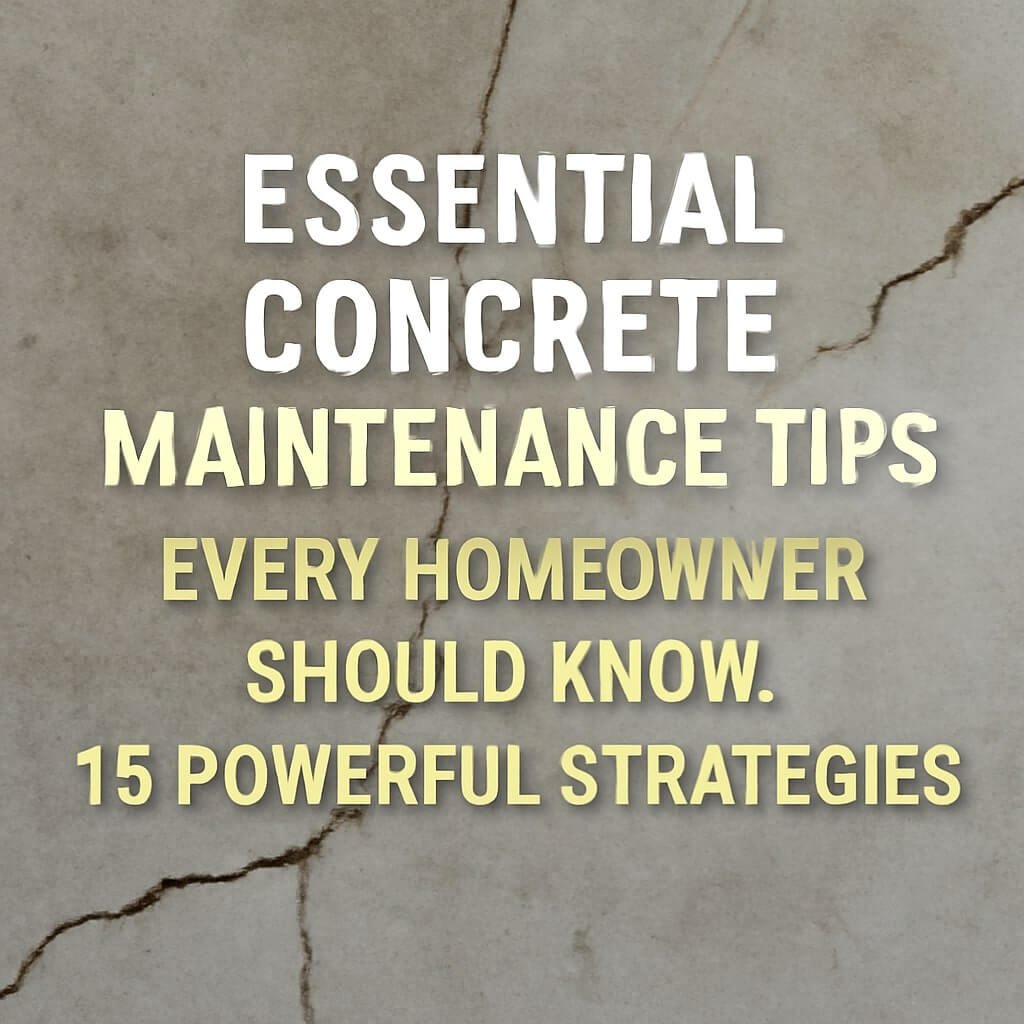Maintaining concrete surfaces around your home is crucial to preserving both their appearance and structural integrity. Concrete, widely used in driveways, patios, sidewalks, and foundations, might seem tough, but it’s far from invincible. Proper care ensures your investment lasts for decades, avoiding costly repairs or replacements. In this comprehensive guide, we’ll walk you through 15 essential concrete maintenance tips every homeowner should know to keep their concrete surfaces in pristine condition.
Understanding Concrete and Its Importance

What Is Concrete?
Concrete is a composite construction material made from a mixture of cement, water, sand, and aggregate (such as gravel). It hardens over time into a solid, durable surface capable of bearing heavy loads and withstanding environmental stresses. Its versatility and strength make it a popular choice for residential and commercial construction projects.
Why Concrete Maintenance Matters
Despite its toughness, concrete is susceptible to damage from weather, chemical exposure, heavy use, and poor installation. Without regular maintenance, small issues like cracks or stains can escalate into serious problems, reducing the lifespan of your concrete and impacting your home’s curb appeal. Proactive care not only preserves safety but also enhances the value of your property.
Common Concrete Problems Homeowners Face
Cracks and Their Causes
Cracking is one of the most common issues with concrete surfaces. Cracks can form due to shrinkage during curing, thermal expansion and contraction, ground settling, or excessive loads. While some cracks are superficial, others can signal structural concerns that need prompt attention.
Surface Stains and Discoloration
Concrete can easily pick up stains from oil, rust, mold, or dirt. These blemishes detract from its aesthetic appeal and may be difficult to remove if left untreated. Understanding the cause of stains helps in selecting the best cleaning approach.
Spalling and Surface Erosion
Spalling refers to the flaking or chipping of the concrete surface, often caused by freeze-thaw cycles, salt exposure, or poor finishing during installation. Surface erosion can weaken the concrete’s protective layer, making it vulnerable to further damage.
Top 15 Concrete Maintenance Tips
1. Regular Cleaning
Keeping your concrete surfaces clean is the first line of defense against damage. Sweep away debris, dirt, and leaves frequently. For deeper cleaning, use a garden hose or pressure washer on a low setting to avoid surface damage. Mild detergents or concrete-specific cleaners work best to remove grime without harsh chemicals.
2. Seal Your Concrete
Sealing concrete creates a protective barrier that prevents water, stains, and chemicals from penetrating the surface. Apply a high-quality concrete sealer every 2-3 years depending on exposure. This step significantly extends the lifespan of your concrete by reducing wear and tear.
3. Inspect for Cracks Routinely
Make it a habit to inspect your concrete surfaces at least twice a year, especially after winter or heavy storms. Early detection of cracks allows you to address them before they grow larger or allow moisture to seep in.
4. Repair Small Cracks Promptly
Small cracks can be repaired easily using concrete fillers or patching compounds available at most hardware stores. For cracks wider than 1/4 inch, consider professional repair to ensure structural integrity.
5. Control Moisture Exposure
Water is one of the biggest enemies of concrete. Ensure proper drainage around your home to prevent standing water on or near concrete surfaces. Installing gutters and downspouts directing water away from concrete areas helps maintain dryness and reduces damage risk.
6. Avoid Deicing Chemicals
Salt and chemical deicers can cause concrete deterioration and spalling during freeze-thaw cycles. Opt for sand or kitty litter for traction instead, especially on driveways and walkways.
7. Use Protective Coatings
In addition to sealers, some homeowners choose to apply epoxy or polyurethane coatings to provide enhanced protection against abrasion and chemicals. These coatings can also improve the appearance by adding color or gloss.
8. Manage Heavy Loads Carefully
Avoid parking heavy vehicles or placing heavy equipment on concrete slabs not designed to bear such loads. Excess weight can cause cracking or settling over time.
9. Maintain Proper Drainage
Water pooling is a serious threat to concrete. Ensure that soil grading slopes away from concrete slabs, and keep drainage systems clean and functional. Proper drainage prevents water infiltration and freeze damage.
10. Remove Stains Quickly
Address stains as soon as they appear to avoid permanent discoloration. Use specialized stain removers for oil, rust, or mold, following manufacturer instructions carefully.
11. Prevent Weed Growth
Weeds growing in cracks or joints can widen them and accelerate damage. Use weed killers safely or apply polymeric sand between pavers to inhibit growth.
12. Avoid Abrasive Cleaning Tools
Avoid using wire brushes or harsh scrubbing pads that can scratch the concrete surface. Soft-bristle brooms or nylon brushes are ideal for cleaning without causing damage.
13. Schedule Professional Inspections
For large areas or noticeable structural damage, hire a professional concrete inspector. They can assess the condition accurately and recommend appropriate repairs or maintenance.
14. Protect Concrete from Extreme Temperatures
In regions with harsh winters or scorching summers, concrete is at risk of thermal stress. Use insulating mats or covers during extreme weather to protect surfaces, and ensure sealants are suitable for your climate.
15. Apply Concrete Resurfacing When Needed
If your concrete surface is extensively worn or damaged, resurfacing can restore its look and strength. This process involves applying a thin overlay of new concrete or a specialized resurfacer that bonds to the old surface.
Frequently Asked Questions About Concrete Maintenance
How often should I seal my concrete surfaces?
Can I repair concrete cracks myself?
What causes concrete stains and how can I remove them?
Is pressure washing safe for concrete?
Why shouldn’t I use salt on my driveway?
Salt accelerates freeze-thaw damage causing cracks and spalling. Safer alternatives include sand or kitty litter for traction.
When should I consider resurfacing my concrete?
Conclusion: Maintaining Concrete for Long-Term Value
Concrete maintenance doesn’t have to be complicated. With regular care, inspection, and timely repairs, you can preserve your concrete surfaces for decades. Remember, the key is prevention—sealing, cleaning, and protecting your concrete will save you money and headaches down the line. Stay proactive and your home’s concrete will remain strong, safe, and beautiful for years to come.



